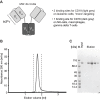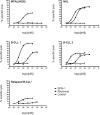CD19-specific triplebody SPM-1 engages NK and γδ T cells for rapid and efficient lysis of malignant B-lymphoid cells
- PMID: 27825135
- PMCID: PMC5347777
- DOI: 10.18632/oncotarget.13110
CD19-specific triplebody SPM-1 engages NK and γδ T cells for rapid and efficient lysis of malignant B-lymphoid cells
Abstract
Triplebodies are antibody-derived recombinant proteins carrying 3 antigen-binding domains in a single polypeptide chain. Triplebody SPM-1 was designed for lysis of CD19-bearing malignant B-lymphoid cells through the engagement of CD16-expressing cytolytic effectors, including NK and γδ T cells.SPM-1 is an optimized version of triplebody ds(19-16-19) and includes humanization, disulfide stabilization and the removal of potentially immunogenic sequences. A three-step chromatographic procedure yielded 1.7 - 5.5 mg of purified, monomeric protein per liter of culture medium. In cytolysis assays with NK cell effectors, SPM-1 mediated potent lysis of cancer-derived B cell lines and primary cells from patients with various B-lymphoid malignancies, which surpassed the ADCC activity of the therapeutic antibody Rituximab. EC50-values ranged from 3 to 86 pM. Finally, in an impedance-based assay, SPM-1 mediated a particularly rapid lysis of CD19-bearing target cells by engaging and activating both primary and expanded human γδ T cells from healthy donors as effectors.These data establish SPM-1 as a useful tool for a kinetic analysis of the cytolytic reactions mediated by γδ T and NK cells and as an agent deserving further development towards clinical use for the treatment of B-lymphoid malignancies.
Keywords: antibody-dependent cellular cytotoxicity; gamma delta T cell; immunotherapy; leukemia; single chain triplebody.
Conflict of interest statement
The authors report no conflicts of interest.
Figures






References
-
- Carter RH, Wang Y, Brooks S. Role of CD19 signal transduction in B cell biology. Immunologic research. 2002;26:45–54. - PubMed
-
- Del Nagro CJ, Otero DC, Anzelon AN, Omori SA, Kolla RV, Rickert RC. CD19 function in central and peripheral B-cell development. Immunologic research. 2005;31:119–131. - PubMed
-
- Ishiura N, Nakashima H, Watanabe R, Kuwano Y, Adachi T, Takahashi Y, Tsubata T, Okochi H, Tamaki K, Tedder TF, Fujimoto M. Differential phosphorylation of functional tyrosines in CD19 modulates B-lymphocyte activation. European journal of immunology. 2010;40:1192–1204. - PubMed
-
- Tedder TF, Inaoki M, Sato S. The CD19-CD21 complex regulates signal transduction thresholds governing humoral immunity and autoimmunity. Immunity. 1997;6:107–118. - PubMed
Publication types
MeSH terms
Substances
LinkOut - more resources
Full Text Sources
Other Literature Sources

